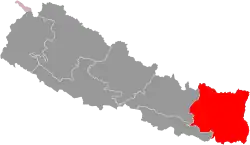| कोशी प्रदेश सरकार | |
| Governance overview | |
|---|---|
| Formed | 20 September 2015 |
| Jurisdiction | Federal Democratic Republic of Nepal |
| Headquarters | Biratnagar, Nepal |
| Annual budget | $9 Billion USD |
| Minister responsible | |
| Parent department | Government of Nepal |
| Website | GOVERNMENT |
| Map | |
 | |
The Government of Koshi, known locally as the Provincial Government, is the supreme governing authority of the Koshi Province which consists of 14 districts.
The Governor of the province is appointed head of the province by the President of Nepal on the recommendation of Federal cabinet for a period of five years unless freed earlier by federal government.[1] The Head of Koshi Province is the Governor (Provincial Chief), and the Chief Minister holds the position of the Head of executive. The role of governor is largely ceremonial as the functioning of the government is managed entirely by the Chief Minister. The governor appoints minister and chief minister based on the articles and clauses of Constitution.
The Koshi government maintains its capital at Biratnagar[2][3] and is seated at the Koshi Provincial Government Secretariat.
Etymology
The province named Koshi after the largest river of Kosi river, which is the largest in the country. On 1st march 2023 the temporary name of the province Province No. 1 changes into Koshi Province.[4] The Kosi river is significantly and culturally an important river of Nepal. The Kosi river is called Kausika in Rigveda and Kausiki in Mahabharata. The Kosi is associated with many ancient spiritual stories. It is mentioned in the Bal Kand section of Valmiki Ramayana as the Kausiki who is the form assumed by Satyavati after her death. In Ramayana Kausiki is mentioned as younger sister of Ganga.
Executive
Head of State
The Governors of the Provinces of Nepal have similar powers and functions at the province (state) level as those of the President of Nepal at National level. According to the Constitution of Nepal, the Governor is a state's head, but de facto executive authority rests with the Chief Minister. The governor acts as the nominal head whereas the real power lies with the Chief ministers of the province and his/her councils of ministers. The Governor of a Province is appointed by the President of Nepal. The incumbent Governor of Koshi Province is Parshuram Khapung, since 20 August 2021.[5][6][7]
Head of Government
In the Federal Democratic Republic of Nepal, a chief minister is the elected head of government of each province. Following elections to the Koshi Provincial Assembly, the governor usually invites the party (or coalition) with a majority of seats to form the government. The governor appoints the chief minister, whose council of ministers are collectively responsible to the assembly. Given that he has the confidence of the assembly, the chief minister's term is for five years and is subject to no term limits.The current Chief Minister of Koshi Province is Kedar Karki, since 15 October 2023.[8]
Secretary
The Chief Secretary of Koshi Province (Nepali: कोशी प्रदेशको मुख्य सचिव) is the chief administrative officer and senior–most civil servant of the Government of Koshi Province. The chief secretary is the head of the Cabinet Secretariat and is the secretary of the cabinet and the constitutional council. The Cabinet Secretary enforces cabinet discipline and coordinates between ministries.The current acting Chief secretary of Nepal is (Deepak Kafle) [9]
Legislature
Officers
Koshi Provincial Assembly
The Koshi Provincial Assembly also known as the Koshi Pradesh Sabha. The legislative structure of the province is unicameral. The Koshi Province Provincial Assembly consists of 93 members of whom 54 are elected through first-past-the-post voting and 37 of whom are elected through proportional representation. The term of the assembly is five years unless dissolved earlier.[10][11]
Judiciary
References
- ↑ "Cabinet recommends guvs, names ad hoc 'workstations'". The Himalayan Times. 2018-01-17. Retrieved 2019-05-31.
- ↑ Sureis (2018-01-19). "Biratnagar celebrates its status of provincial capital". The Himalayan Times. Retrieved 2023-03-15.
- ↑ "Locals intensify protest in Dhankuta after Biratnagar named as provincial HQ". kathmandupost.com. Retrieved 2023-03-15.
- ↑ "Nepal's 'Province 1' renamed 'Koshi' after country's largest river". Canada Asia Sustainability Tracker. 1 March 2023. Retrieved 9 March 2023.
- ↑ "State chiefs Khapung, Pariyar and Joshi took oath". English.MakaluKhabar.com. Retrieved 2023-03-15.
- ↑ Today, N. L. (2021-11-09). "President appoints province chiefs in three provinces". Nepal Live Today. Retrieved 2023-03-15.
- ↑ "Government changes three provincial chiefs". kathmandupost.com. Retrieved 2023-03-15.
- ↑ "Kedar Karki of Nepali Congress appointed Koshi chief minister". kathmandupost.com. Retrieved 2023-10-14.
- ↑ "प्रमुख सचिव | मुख्यमन्त्री तथा मन्त्रिपरिषद्को कार्यालय". ocmcm.p1.gov.np. Retrieved 2023-03-12.
- ↑ "Nepal elections explained". www.aljazeera.com. Retrieved 2019-06-04.
- ↑ "CDC submits its report with 165 electoral constituencies". kathmandupost.ekantipur.com. Retrieved 2019-06-04.